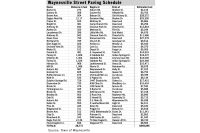Trick bikes fall from grace at Waynesville’s skate park
 The Waynesville skate park became an instant rock star after its debut last fall, gaining repute as a wildly popular concrete playground for all things on wheels gliding, sliding and flying over the ramps and rails all hours of the day.
The Waynesville skate park became an instant rock star after its debut last fall, gaining repute as a wildly popular concrete playground for all things on wheels gliding, sliding and flying over the ramps and rails all hours of the day.
But the town last week decided to sideline some of the park’s biggest fans. BMX bikers have been banned by the town due to nicks in the concrete. When the town leaders discussed the issue at a meeting last week, Town Manager Marcy Onieal braced them for backlash.
“If we make a change there will certainly be some disappointment,” said Onieal. “But we obviously have a huge investment in this, and to have this kind of damage a few months in is a little discouraging.”
After mulling over photos of the nicks, town leaders reluctantly signed off on the BMX bike ban at the skate park, which cost $445,000 to build.
But bikers who used the park say the ban is an overkill, and some skateboarders have spoken out in the bikers’ defense as well.
Related Items
The culprit isn’t the bikes themselves. The nicks are caused by 7-inch steel pegs that protrude from the wheels. Bikers stand on the pegs for advanced tricks or balance their bike on rails and ledges using the peg as a fulcrum.
But only a small minority of BMX bikers actually use pegs.
“I have never ridden pegs in my life,” said Matt Green, a 25-year-old trick biker who lives in Bryson City but frequents the skate park in Waynesville. “Most people around here don’t use pegs, and those that do use plastic pegs.”
The carte blanche ban on bikes is unfairly punishing everyone, bikers claim.
“This is a huge loss for cyclists in Western North Carolina,” said Evan Voss, a designer at Cane Creek Cycling Components in Asheville. “Pegs are easily removable from bikes. It’s kind of absurd to ban a bike because of an element that is removable.”
Nice thoughts in a perfect world
For skateboarders, the bike ban isn’t cause for celebration. They didn’t mind sharing the park, according to Jared Lee, a professional skateboarder in Waynesville.
“I see the town’s concerns with the pegs damaging the concrete. That is something you don’t want to ignore. But banning bikes, I consciously don’t feel right about that,” Lee said. “They just want to do what they love.”
A wholesale ban on all bikes goes overboard, he said, suggesting simply banning steel pegs.
But that would be too hard to monitor and enforce, according to Waynesville Recreation Director Rhett Langston. The town would need constant supervision to make sure the bikes using the park don’t have pegs.
“It would be really hard for the town officers to go out there and inspect the bikes and say ‘Hey, do you have pegs? You have to take them off if you do,’” admitted Green. “It would be a lot more of a hassle.”
Lee conceded that point as well.
“It is easier to regulate no bikes than check what kind of peg each person has on their bikes,” the skater agreed.
But the town wouldn’t have to be the one doing the monitoring, Lee said. The users of the park would self-police. It is a tight-knit community, and he believes the other skaters and bikers would exert social pressure on anyone that showed up with pegs.
“All of us skaters would enforce that,” Lee said. “This is our park, it is the only one we are ever going to get. We want to take care of it.”
Langston isn’t so sure self-policing or enforcement through peer pressure is a viable solution.
“It is a nice thought in a perfect world, but that isn’t going to work,” Langston said.
Skateparks in other parts of the country, however, have successfully banned pegs rather than all bikes.
“There are plenty of alternatives to work around the pegs issue other than banning bikes,” said Voss, a former Western Carolina University student who worked at Motion Makers Bike Shop in Sylva while in school.
A tight-knit bunch of whirling dervishes
For a novice to such circles, the scene at the skate park seems like a haphazard free-for-all of close encounters and near misses, a whizzing pack of whirling dervishes running amuck.
But in fact, there are strict rules of etiquette that govern the park. The flow of skateboards and bikes over the ramps and bowls is a lot more organized than it looks, which is one reason there’s so many “near misses” and very few, if any, hits.
But it can be nerve-racking to spectators, especially when little kids are out in the middle of it all. And the risk of a collision seems even scarier when bikes are in the mix.
“You got 4-year-old little girls on roller skates right up there with 25-year-olds doing national competition tricks on bikes, and they are going like this,” Alderman LeRoy Roberson said, sliding his hands past each other in the air. “It seems like it makes it more dangerous.”
Although plenty of skate parks ban bikes, Waynesville tried to be inclusive, largely on the good word of the skateboard community. During planning stages for the park, skaters vouched for the bikers and said they should be allowed.
Lee said he personally spoke up for allowing bikes and making the skate park multi-use.
In some urban areas, bikers and skaters are distinct groups and prone to tension. Those lines don’t appear to exist in Waynesville.
“Around here it’s always been really good,” Green said.
Lee hopes the bike ban won’t create ill will.
“The skate park, so far, has run so smoothly and calmly, and now I feel like there will be upset people and there will be a lot of quarreling over it,” Lee said.
Word of Waynesville’s skate park spread rapidly after it opened last fall. A loose-knit community of skaters and bikers stretches across the region, and they intersect as they hop around to skate parks.
It’s common to travel two or three hours to ride different parks, much like a paddler ventures to different rivers and skiers to different ski slopes.
While the Waynesville skate park is a proving ground for skateboarders and trick bikers from the mountain region and beyond, it is also giving rise to local kids picking up a new form of recreation.
Some youth have taken up the sport of BMX biking since the park came on line, spending money on equipment for the new-found hobby — only to see it taken away.
Langston said he wasn’t aware of the side effects bikes with pegs could have for a skate park until recently.
“We were basically blindsided. We didn’t realize it was going to tear anything up,” Langston said.
Langston was first alerted to the concrete nicks by the maintenance director for the Waynesville Parks and Rec Department. Langston didn’t know what was causing it, so he sent pictures of the nicked spots to the firm that built the park for the town.
Artisan, skate park builders from Kitty Hawk, N.C., quickly replied that it was the telltale signs of bike pegs.
Green questioned whether the pegs are really causing the damage, however. All skate parks get wear and tear, and besides, it’s patchable, he said.
“I think it is blown out of proportion,” Green said. “I don’t think they cause the damage people say.”
Waynesville Mayor Gavin Brown asked if there was another explanation for the concrete damage. Brown didn’t want to blame bikes if they weren’t in fact the cause.
As a consolation, Onieal explained that a lot of skate parks struggle with the bike conundrum.
“This is a problem for skate parks, period,” Onieal said.
The skate parks in Asheville and Hendersonville ban BMX bikes. One in Cherokee does not.
There are a few other drawbacks to bikes at the park, Langston said. While bikes are clearly in the minority of users, fears of collisions are heightened by bikes. Bikes were also running over landscaping around the park and keeping grass from taking seed.
And it also opened a can of worms for other types of bikes, from scooters to little kids on bikes with training wheels.
Alderman Gary Caldwell, a tireless champion of the skate park for 15 years, said the town can’t risk a handful of bikers damaging the skate park for its intended use.
“It was built generally for a skate park,” Caldwell said.
But Lee said he wishes the town consulted those who use the skate park.
“Why not ask the people using it what is the best solution?” Lee said.









